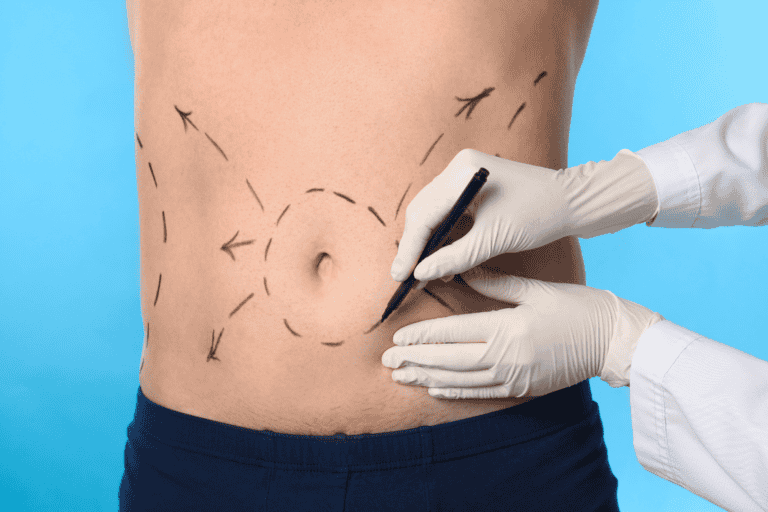What is male abdominoplasty, and why is its popularity rising?
Male abdominoplasty (tummy tuck) procedures have increased by 114% since 2003, with over 3,400 men undergoing the procedure in 2022 alone. This surge comes from changing societal attitudes, more weight loss interventions, and advances in surgical techniques that create natural-looking, masculine results. While men face slightly higher complication risks than women, proper candidate selection and preoperative planning can greatly improve outcomes and satisfaction rates.
How are societal attitudes changing toward male plastic surgery?
The days when plastic surgery was seen as only for women are behind us. Today, men across Chicago and nearby suburbs are embracing cosmetic procedures to enhance their appearance and boost confidence. This shift is more than a trend—it reflects a fundamental change in how we view masculinity and self-care.
More men are embracing cosmetic procedures as a way to boost confidence and maintain a refreshed appearance. It’s no longer seen as vanity, but rather a proactive approach to feeling comfortable in one’s own skin. The stigma around male aesthetic treatments has declined notably in recent years, reflecting a broader shift toward self-care and wellness.
This cultural shift shows in the numbers. According to the American Society of Plastic Surgeons, male tummy tucks have increased by 114% since 2003, with 3,463 procedures performed in 2022 alone. Google search data shows a 41% annual growth in “male abdominoplasty” queries, showing rising interest and acceptance.
Why are more men choosing abdominoplasty?
The Post-Weight Loss Journey
One main reason for the rise in male abdominoplasty is the growing number of men who have lost significant weight. Whether through bariatric surgery, lifestyle changes, or newer GLP-1 agonist medications like semaglutide, many men deal with excess abdominal skin that no amount of exercise can fix.
Approximately 35% of male patients who undergo significant weight loss after bariatric surgery choose to have abdominoplasty. Major weight loss often leaves behind excess skin that lacks the elasticity to conform to the body’s new shape, leading to both cosmetic concerns and functional challenges—issues that abdominoplasty is well-suited to address.
For Chicago-area residents who have worked hard to lose weight, the loose skin can feel like an unfair reminder of their former selves. Daily activities like exercise can become uncomfortable, and finding clothes that fit well remains a challenge despite weight loss success.
What does male abdominoplasty involve?
The Masculine Aesthetic Difference
Male abdominoplasty differs a lot from the female version. While women often want curvy contours, men usually want a more angular, defined abdominal look that highlights muscularity.
The male aesthetic emphasizes a sculpted, “six-pack” appearance by enhancing the definition along the lateral borders of the rectus muscles. Achieving a natural, masculine look also involves precise repositioning of the umbilicus (belly button) using anatomical landmarks and tailored measurements to ensure balance and symmetry.
Research shows the ideal male umbilicus position matches inter-nipple measurements, following the formula U-AX = 1.618 × N-N for the most natural appearance. This attention to male-specific proportions helps achieve results that look authentic rather than surgically made.
Combined Approaches for Optimal Results
For many men, the best abdominoplasty combines multiple techniques:
- Traditional skin and fat removal: Removing excess abdominal skin and fat
- Muscle plication: Tightening separated abdominal muscles (rectus diastasis)
- High-definition liposuction: Sculpting to enhance natural muscle contours
- Umbilical repositioning: Creating a naturally masculine navel appearance
Many male patients achieve the best results through a combined approach that targets both excess skin and fat while enhancing muscle definition. This comprehensive method helps create a natural, masculine appearance and supports long-lasting, transformative outcomes.
Who is a good candidate for male abdominoplasty?
Not every man is an ideal candidate for abdominoplasty. Knowing who benefits most helps set realistic expectations and improve outcomes.
Physical considerations
The best candidates for male abdominoplasty usually:
- Have kept a stable weight for at least 12 months
- Are in good overall health without uncontrolled medical conditions
- Have excess abdominal skin that hasn’t improved with diet and exercise
- Have realistic expectations about results and recovery
- Are non-smokers or willing to quit before and after surgery
BMI is a key consideration when evaluating surgical candidates. While each patient is assessed individually, studies show that complication risks increase notably with a BMI of 30 or higher, particularly in male patients. Therefore, careful preoperative planning is essential for safety and optimal outcomes.
Psychological readiness
Besides physical factors, psychological readiness plays a key role in satisfaction. Men considering abdominoplasty should:
- Be pursuing the procedure for themselves, not to please others
- Understand the temporary lifestyle changes needed during recovery
- Have a support system for the recovery period
- Be ready for the emotional aspects of physical transformation
What is the recovery process like after male abdominoplasty?
Male patients often have different recovery experiences than female patients, partly due to anatomical differences and activity patterns.
Men often have thicker abdominal tissue and distinct fat distribution compared to women, which can influence both the surgical technique used and the pace of recovery. These anatomical differences are important considerations when planning and managing cosmetic procedures for male patients.
What is the recovery process like after male abdominoplasty?
Most male patients can expect:
- 1-2 weeks: Initial recovery with limited movement
- 3-4 weeks: Return to light work and mild physical activity
- 6-8 weeks: Resumption of more strenuous exercise and heavy lifting
- 3-6 months: Final results appear as swelling fully goes down
A common challenge with male patients is ensuring they follow activity restrictions during recovery. Many are eager to resume workouts or physical labor too soon, which can jeopardize healing. Adhering to postoperative guidelines is essential to achieving optimal results and preventing complications.
Understanding male-specific risks
Research shows male patients face a 1.3–1.5 times higher risk of major complications compared to females, including:
- Higher venous thromboembolism (VTE) rates (2.8% in males vs. 1.1% in females)
- Increased wound infection risk (8.3% vs. 4.7%)
- Greater chance of seroma formation (12.1% vs. 6.9%)
These stats highlight the importance of choosing a surgeon experienced with male abdominoplasty who knows these unique risks and uses proper preventative measures.
How can Chicago men get started with male abdominoplasty?
If you’re a man in the Chicago area thinking about abdominoplasty, taking the right steps can help you get the results you want.
Schedule a consultation
The first step is a thorough consultation with a board-certified plastic surgeon experienced in male-specific procedures. During this appointment, you’ll discuss:
- Your specific goals and expectations
- Your medical history and current health
- The best surgical approach for your body type
- Realistic outcomes based on your anatomy
- Recovery timeline and post-operative care
Ask the right questions
Come prepared with questions like:
- How many male abdominoplasty procedures have you done?
- Can I see before-and-after photos of male patients with similar body types?
- What complications have your male patients had, and how were they handled?
- What techniques do you use to create natural-looking masculine results?
- How should I prepare for surgery and recovery?
Is male abdominoplasty right for you?
The decision to have male abdominoplasty is deeply personal. As societal attitudes keep changing and surgical techniques improve, more men find that tummy tuck surgery solves concerns that affect both their appearance and quality of life.
What truly matters is how the procedure impacts a patient’s confidence and quality of life. Success is measured not just by surgical results, but by the moments when patients feel comfortable in their own skin, whether it’s taking off their shirt at the beach or enjoying everyday activities without the discomfort of excess skin.
If you’re considering male abdominoplasty in the Chicago area, contact St. Charles Plastic Surgery to schedule a consultation with Dr. Ghaderi. With nearly two decades of experience serving patients throughout Chicago and its suburbs, our team understands the unique factors involved in creating natural, masculine results that help you feel confident in your own skin.
Note: This article is for informational purposes only and does not constitute medical advice. Please consult a healthcare professional for personalized guidance.




